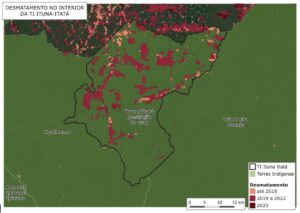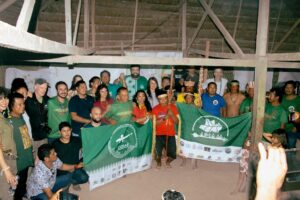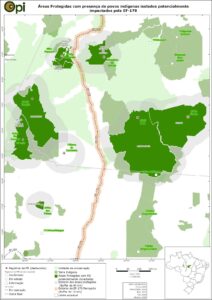Ten years after its first version, the project is back with a new outline: proposed and implemented by the Amondawa Indigenous People's Association.

In 2013, employees of the National Foundation of Indigenous Peoples (Funai) realized that the inspection and monitoring situation in the southern region of the Uru-eu-wau-wau Indigenous Land, especially in the area of the BR-429 federal highway, in Rondônia, was becoming more difficult due to an increasing number of minor crimes like invasions for fishing, Brazil nut collecting and logging, illegal mining activities are also on the increase. Worried about the situation, indigenist Rieli Franciscato, then coordinator of the Uru-eu-wau-wau Ethno-Environmental Protection Front (FPE-Funai), began to realise that grassroots work in communities surrounding the territory could work more effectively in combating these crimes. He sought out Walter Meira, deputy coordinator of the same Front, and together they created the first version of the project, initially called Um Dia de Campo (A Field Day), now renamed Um Dia na Aldeia (A Day in the Village).
In Seringueiras-RO, they gave talks to children in rural schools, telling them about Funai's activities, talking about the importance of the territory from an environmental point of view, and the protection of the isolated indigenous people who live there. They also aimed to point out the difference between indigenous and non-indigenous occupation, the former co-existing with the forest, and the latter, predatory. At the end, the students who showed the most interest in the topic were selected to visit the base of the Ethno-Environmental Protection Front (FPE-Funai) in Indigenous Land, and see what they had learnt being put into practice.
The Amondawa people have participated since the first versions of the project, presenting their way of life and showing their relationship with the forest, which has continued even after the establishment of regular contact with non-indigenous people in 1988. The field activity is planned in work stations where they can see different topics they’ve learnt about in practice, with the Amondawa showing the plants that are important for food, medicine, homebuilding and the production of artefacts in their own work station.
The project stemmed from the need to bring information to the surrounding society about the importance of the territory for isolated peoples and to reduce environmental crimes committed by neighborhood residents. It was repeated by Funai in 2014, 2015 and 2016, expanding and reaching professionals, teachers, civil servants and academics, extending to the Rondônia towns of São Miguel, São Francisco and Izidrolândia, the latter aiming to inform about the same issue, but focusing on the Massaco Indigenous Land, demarcated exclusively for people who live in isolation.
Amondawa Protagonism
After the tragic death of Rieli Franciscato in 2020, killed by an arrow to the heart at a time of great tension for isolated groups in the region. Pressured by numerous invasions, the Amondawa indigenous community, for whom Rieli was a figure of great importance, felt his absence in many ways, including the positive impacts of the project he coordinated. Day in the Village promoted territorial protection, combating prejudice against indigenous peoples in the region, informing about the environmental importance of the territory and respect for isolated indigenous peoples, through education. The project made a difference and when it stopped it was missed.
In 2023, ten years after its first version, the project was reinitiated with a new approach: proposed and implemented by the Amondawa Indigenous People's Association (Apia), in schools in the towns of Mirante da Serra and Nova União. The project was financed by the Inter-American Foundation (IAF), and was carried out in partnership with the Observatory for the Human-Rights of Isolated and Recently Contacted Indigenous Peoples (Opi), the Federal University of Rondônia (Unir), the Uru-eu-wau-wau Ethno Environmental Protection Front (FPE-Funai) and the Coordination of Indigenous Organizations of the Brazilian Amazon (Coiab).
After months of preparation, a team composed exclusively of Amondawa indigenous people, together with an advisor from Opi, held the lectures in eight schools, which were very well received by the entire school community. The Uru-eu-wau-wau and Madeirinha Ethnoenvironmental Protection Fronts made Amondawa employees available to attend the event, contributing to the clarification of institutional actions and their importance.
The team was made up of men and women from the Amondawa people, with presentations made by André Tanguip, Baíra, Borep, Davi Kuari, Puruwa, Poteí, Tambura and Warina, in addition to Graciano Oro Waram, the association's communicator. At the end of this stage, the schools were responsible for selecting students whose essays showed them to be most engaged with the topic for a visit to the Trincheira village, in the Uru-eu-wau-wau Indigenous Land.
Day in the Village


The second stage of the activity, which gives the project its name, brings the community closer to the reality of indigenous life in their territory. The visiting day took place at the beginning of November and involved around 500 people, 300 of whom were visitors. The public included selected students and teachers, including those from the Centro Universitário São Lucas, councillors, among others. After being welcomed, they went in small groups for a 2 kilometre walk along a trail prepared in the forest.
On the guided walk, ten work stationshad been organised in advance where explanations of the forest activities were given. There was the ywypiroca medicinal plant (monkey slide), the Brazil nut tree, the embira, the palm tree from which they get salt, the rubber tree, the pestle tree, the caucho, a tapiri of the isolated (simulated), the Amondawa tapiri and the hunting ground. After this, people gathered for a large collective lunch and activities including a raffle, games, dances and songs. At the end, native plant seedlings were given to the visitors, including some of the mahogany tree (target of illegal loggers) to demonstrate the strength of environmental protection in the indigenous territory.
The project helped to improve relations and pass on information to the region's residents, encouraged cultural appreciation and boosted local income, as indigenous crafts were also sold during the day. The involvement of young people in the activities helped to revive and strengthen Amondawa culture, which was deeply appreciated by the community.
The Amondawa liaised with local authorities (mayors, councillors, secretariats, schools) and institutions such as those mentioned above. This is the only ongoing project in Rondônia state which has the support of the Inter-American Foundation, and has been recognised for its good administration and results.
Follow this and other activities carried out by the Amondawa Indigenous People's Association (Apia) on the Amondawa Instagram page..





